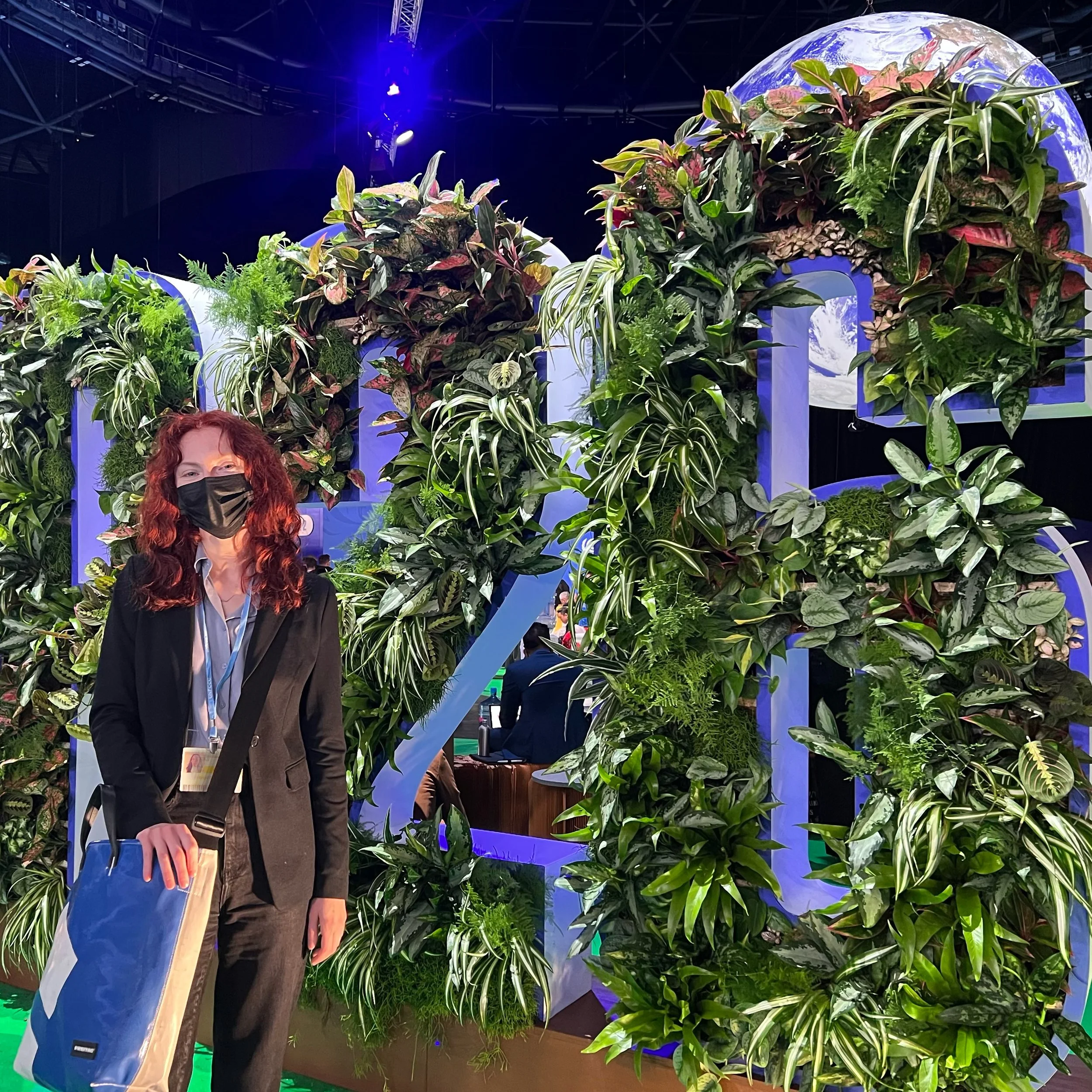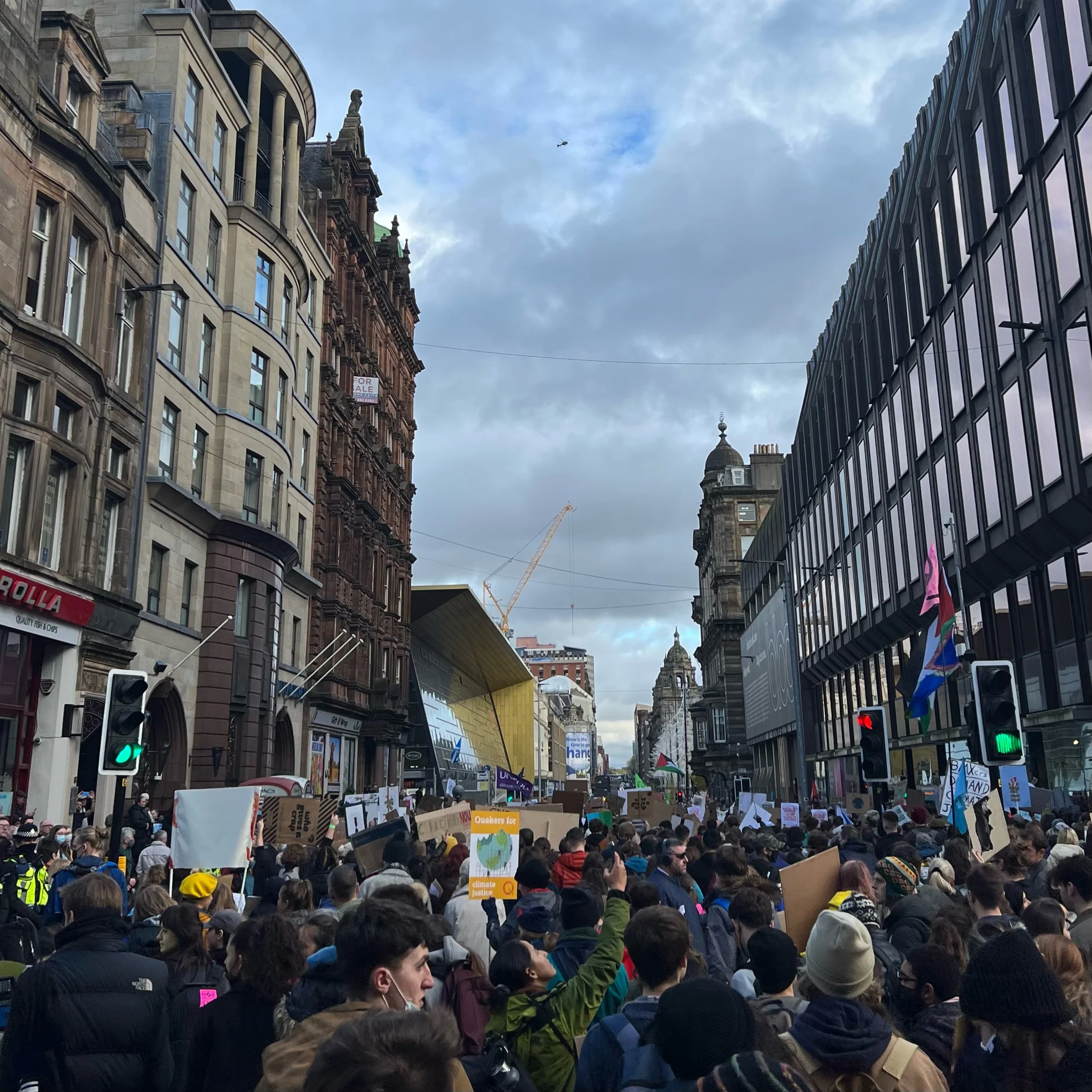Attending COP26 during COVID-19
By Brigid Deegan
“I’m really worried about what will happen to us after you all leave,” a local artist told me towards the end of my week in Glasgow, “The pubs can close, that’s fine by me. But if I have to spend another winter unable to see my family because of the Convention, I’ll be beside myself.” The pandemic was at the heart of dialogues I heard while attending the first week of COP26. It was seen in the lack of chairs and competitiveness to make it into an event before the room hit capacity. Most importantly, it was felt in the gaps of who was missing, everyone we had lost since January 2020.
I had not set foot on a plane in almost two years. It was hard not to feel as if I were being suffocated the first two days at COP26. Having been largely recluse throughout the pandemic thus far, attending super-spreader events was at the bottom of my to-do list. Masks were on, mostly, however it was the sheer density of crowds that tossed precaution out the window. If so much of a glimpse of Greta Thunberg was seen, a well-maintained socially distanced hallway in the Blue Zone Pavilions would quickly turn into a crushed frenzy.
Brigid Deegan at COP26
Due to concerns of COVID-19, observers weren’t allowed to sit in on the World Leaders Summit and open plenary sessions for a majority of the my visit. This wrench in my plans meant that a great deal of my time was spent inside side events and panels offered by delegations and NGO partnerships in the pavilions. Although this was not how I had initially seen my week panning out (as I was looking forward to spending hours watching negotiations), I was exposed to a side of COP26 that I otherwise would have missed.
A significant reason as to why I wanted to attend COP26 is because I am interested in climate change and migration, specifically looking at how cities engage or ignore migrant communities in climate change resilience planning, community engagement, and sustainable urban development. Much of my prior and current work is specifically with communities in low-lying urban coastal areas within the Asia-Pacific region. Such voices, as well indigenous peoples, the youth, and more generally, those who are the most vulnerable and at the frontlines to the impacts of climate change, are who I and so many others believe should be included at the forefront of such international dialogues. With this in mind, I was really interested in witnessing, firsthand, dialogues at the intersection of migration with climate justice and international policy in order to see whether or not inclusiveness was legitimately being taken seriously by the UNFCCC and negotiating Parties.
While these communities were present and active at COP26, their presence was largely excluded in negotiations and overshadowed by wealthy nations and external actors, such as the fossil fuel industry, who had an overwhelming presence. I overheard someone moments before a presentation on community engagement and empowerment say under their breath, “It feels like there are multiple COP26s going on at once.” They were right. There was an apparent curtain drawn between who was able to participate in and influence the negotiations versus everyone else. Frustration was evident both throughout the halls of the Scottish Entertainment Center and outside on the streets of Glasgow.
It was through side events, discussions at pavilions, and through protests, such as Fridays for Future, that I was able to hear their firsthand accounts of the impact of climate change on their lives and desire to incorporate local knowledge and experiences with governmental actors. However, in many instances, these very frank and sobering dialogues were far removed from the negotiating table and mainstream media. While every conversation I engaged in or witnessed offered a different perspective, these stories had the same core messages: We are far from having the necessary transparency and reporting mechanism, financing measures, and accessibility and inclusion needed to tackle the stark urgency of our climate crisis. We are not being flexible enough to react immediately. Many offered the same grim words I had been thinking to myself throughout the week at COP26—So many of our systems must be seriously restructured. But how can we do that? And what would this possibly look like?
Fridays for the Future protest lead by Greta Thunberg
When I reflect on COP26, it’s very hard to feel hopeful. Time has run out and this shouldn’t come as a surprise to anyone. I’ve been trying to mitigate the apocalyptic narratives and climate existentialism drifting around in my head, as they can be incredibly harmful especially for narratives in the general public. But it is, however, necessary to remain realistic. Especially considering the pandemic we are still going through and having yet properly addressed the gross international inequalities it has further exposed.
With this in mind, there were many moments throughout my week there that I was deeply moved by youth activists, indigenous communities, and historically marginalized groups that I met and listened to throughout the week. Accountability will continue to be held. There is great power in the voices and actions of the people. The mobilization of youth calling for nations to address loss and damage and an end to fossil fuels will not cease to exist. “We have prepared. We are ready to act. We just need the money to get going,” an audience member declared when a financing event opened for interventions. Later that day at an entirely different panel echoed this exasperatedly, “Where is the money? I know it's out there, but who is actually receiving it?”
“If I learned anything from my time at COP26, it would be this: There are good people in the world who care deeply for their communities and environment and will continue to keep moving forward without waiting for world leader’s to get their acts together.”
Innovations to make our energy transitions not only green, but just, will continue to dare us to be more creative in our solutions. There are bold women and fellow students at the Fletcher School who are climate leaders that I am proud to look up to. But that is not enough. Big changes are and will be happening soon across the international system and we must hold our leaders accountable to do more. ∎
Brigid Deegan is a second-year MALD student at The Fletcher School, Tufts University.
Read Clara Cho’s reflection on her trip to the COP here, and stay tuned for more posts from the Tufts University COP26 delegation.


